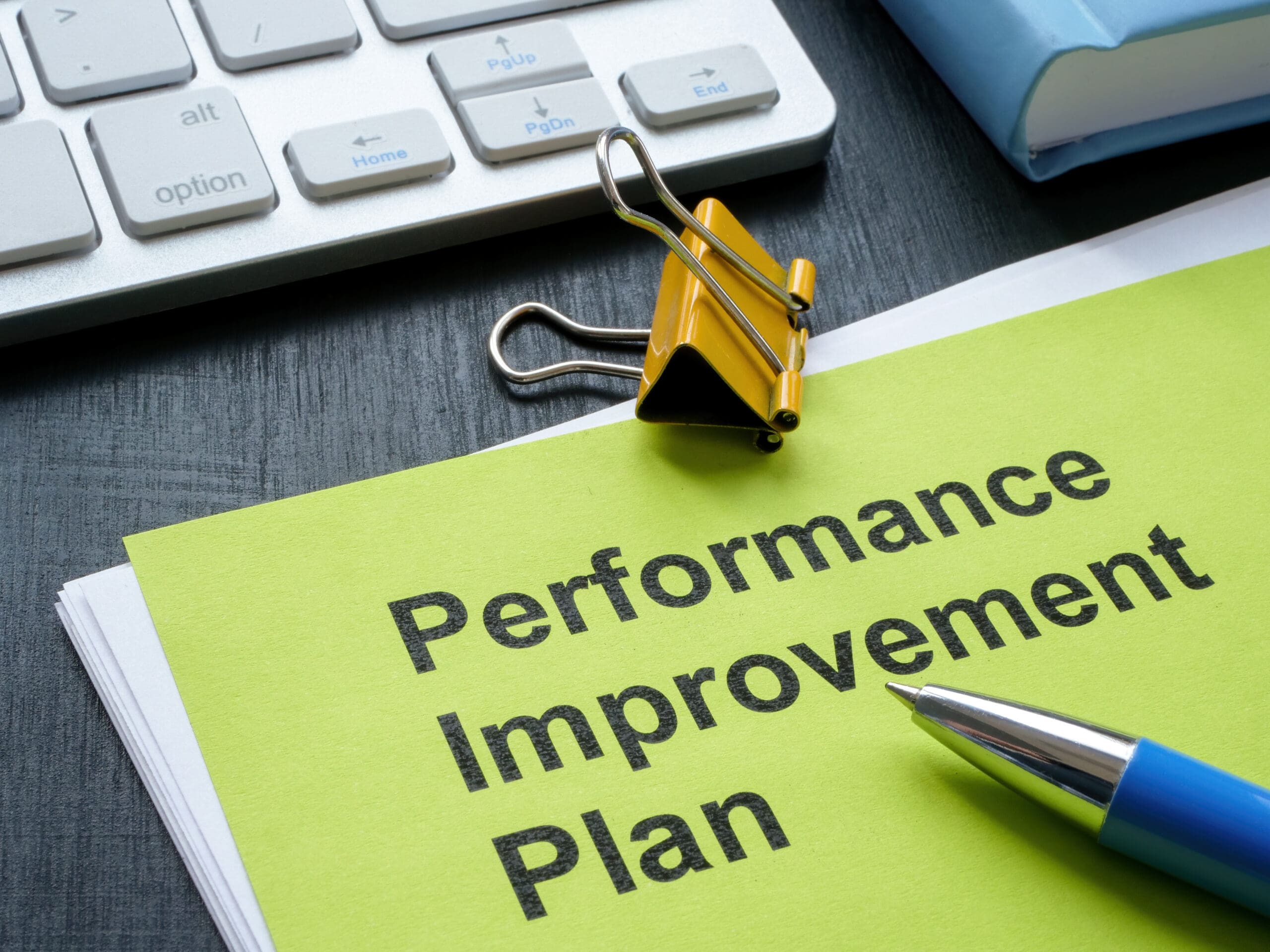
October 15, 2023
Key Steps: What to Do If You’re Put on a Performance Improvement Plan
When you’re put on a Performance Improvement Plan (PIP), it’s vital to act swiftly to safeguard your job and understand the implications. This article lays out clear, actionable steps you can take from day one, including what to do if you’re put on a pip. Discover how to evaluate your PIP objectively, address immediate challenges, and chart a course for the days ahead. Keep your career on track and turn this hurdle into an opportunity for development.
Key Takeaways
Understanding the PIP: It is vital to fully grasp the Performance Improvement Plan by obtaining a written copy, reviewing performance metrics and performance goals, seeking clarification on any ambiguous terms, and understanding the duration and review periods of the PIP. This ensures clear comprehension of expectations.
Seeking Legal Advice: Given the complexity of employment laws, consulting with an employment lawyer helps understand one’s rights and obligations, assess the legality of the PIP, and identify any potential legal issues, thereby equipping oneself to safeguard rights during the PIP process.
Documentation: Keeping a meticulous record of all related interactions, achievements, and any evidence of meeting PIP goals, along with documenting any unfair treatment, is critical for defending one’s rights if necessary.
Effective Communication: Maintaining open and regular communication with supervisors and HR, seeking feedback, being receptive to constructive criticism, and addressing concerns promptly are essential steps in demonstrating commitment to improving performance.
Exploring Employment Options: While focusing on meeting PIP objectives, it’s wise to also consider alternative employment opportunities both within and outside the current organization, ensuring readiness for any outcome by updating resumes, professional profiles, and networking.
Understanding Your Performance Improvement Plan (PIP)

When an employee’s performance falls short of the company’s expectations, Performance Improvement Plans (PIPs) come into play to bridge this gap. These plans are comprehensive and identify specific areas where performance issues exist. They set clear, measurable targets that employees should aim for and delineate resources that the company is willing to provide in support of achieving these goals. PIPs usually span across 30, 60 or 90-day periods and involve regular meetings to review progress – offering guidance and maintaining open lines of communication throughout the process. It’s important to recognize that failure to meet PIP objectives can result in serious ramifications such as demotion or termination from employment.
Grasping your role within a PIP is essential for converting a potentially difficult situation into one with opportunities for professional advancement. Thoroughly understanding every aspect of the document you receive as part of your PIP—and keeping an eye out for any warning signs—is crucial during this process.
Deciphering the Document
After you receive your Performance Improvement Plan (PIP), it’s essential to fully understand the content. The PIP must distinctly define any performance issues, provide supporting evidence, and spell out acceptable standards of performance that correlate with job descriptions and relevant policies for added clarity. It is important that feedback in the PIP is centered around specific behaviors, defined expectations, and desired outcomes—utilizing clear-cut and straightforward language throughout. The goals set forth by the performance expectations in this document should be equitable and attainable within an established reasonable period.
While deciphering this document may seem overwhelming at first glance, keep in mind that it serves as a guide designed to help elevate your work performance. Nevertheless, stay alert for potential warning signs or concerns embedded within its contents.
Identifying Red Flags
A PIP, although purportedly used for enhancement purposes, may be indicative of a potential setup for dismissal. It is essential to discern such warning signs to safeguard your own interests. For example, if the PIP has goals that are ambiguous or extremely ambitious and seem beyond reach, it may point towards a trap designed for failure rather than success. The objectives outlined should represent attainable targets rather than setting an impractical course leading to possible discharge.
A noticeable shift in managerial behavior might also hint at the intention behind the PIP being less about improvement and more about laying grounds for termination. If you observe increased scrutiny over minor errors or faults from your manager coupled with an escalation in reprimands—or heightened email record-keeping—it could suggest they’re building up justification for ending employment. Assessing how traditionally within this company context PIPs have been administered will offer insight into their real intent.
Initial Reactions and Next Steps

Experiencing a range of emotions is common when you are placed on a PIP, as it can be an unsettling and distressing process. To approach the situation properly, give yourself time to come to terms with these feelings. When you’re ready, take on the PIP constructively and proactively by working closely with your manager and being receptive to suggestions for improvement. Keeping open lines of communication through consistent meetings will demonstrate your dedication to meeting the expectations set out in the PIP.
Before diving headlong into rectifying matters, pause for introspection and maintain composure. After this period of reflection, make arrangements for a follow-up meeting where you can delve deeper into discussing all aspects of the PIP’s requirements in detail with your manager.
Stay Calm and Reflect
Finding yourself on a PIP may initially lead to feelings of surprise and anxiety. It’s crucial to take a step back from the initial discussion regarding the PIP, attend to your own well-being, and achieve a state of clarity before deciding on how you will proceed.
Allow yourself some time to absorb what has been communicated, contemplate your emotional response, and organize your thoughts. Take deep breaths. Keep in mind that this is merely an obstacle along your professional journey rather than its conclusion. After regaining composure, make arrangements for a follow-up meeting with your manager to discuss Actions.
Schedule a Follow-Up Meeting
It is essential to have a follow-up meeting as part of the Performance Improvement Plan (PIP) process. Should your manager not initiate such a meeting, it’s advisable that you proactively arrange one to cover all aspects of the PIP comprehensively. In this discussion, aim for explicit comprehension regarding the objectives, timeline, and what is expected from you within the framework of the PIP. Request specific examples if any aspect remains ambiguous. Ideally, scheduled meetings should take place at key intervals – initially upon commencement of PIP, midway through its term and finally at its conclusion – with options for additional brief weekly check-ins when necessary.
The following are imperative during these interactions:
Systematically record each conversation about performance including principal points raised.
Agreement-upon action items and scheduling details concerning subsequent encounters.
Participate in an exchange of feedback consistently.
Maintain candid and frequent communication channels with your manager.
By embracing this approach attentively throughout your participation in the PIP program can lead to greater insight into both your progress relative to goals outlined by said plan.
Creating a Plan of Action

After grasping the details of your Performance Improvement Plan (PIP) and managing your initial feelings, it’s essential to craft a strategic approach for tackling the plan. This involves:
Determining if establishing a well-defined action strategy with scheduled objectives is advantageous.
Creating SMART goals that encompass specificity, measurability, attainability, relevance, and timelines.
Engaging in regular check-ins with your manager to showcase dedication toward improvement.
Instituting a steady rhythm for these discussions as part of your strategy in responding to the PIP.
It’s vital to identify and secure any extra training or resources required to fulfill the stipulations outlined by the PIP successfully. For maximum efficacy of a PIP initiative, showing eagerness for progress coupled with an openness towards enhancement—and carefully logging all efforts directed at accomplishing set targets—is crucially important as you navigate through setting those goals and monitoring their fulfillment moving forward.
Set Clear Goals
Ensure that your response plan for the Performance Improvement Plan (PIP) directly aligns your objectives with the required performance standards. Identify specific areas where enhancement is needed and establish precise targets for progress. These goals should be equitable, accompanied by achievable deadlines to avoid setting you up to fail.
Foster a culture of transparent dialogue where there is flexibility to talk about and modify goals and tasks in response to changing circumstances. Having well-defined benchmarks for satisfying PIP stipulations enhances their transparency and fairness. It’s important to remember that keeping a record of steps taken towards fulfilling PIP objectives within your action plan is crucial. This evidence will undergo scrutiny during periodic review sessions.
Track Your Progress
It is essential to monitor your advancements diligently when engaged in a PIP. Meticulously record any enhancement in your performance, noting the fulfillment of mandated PIP criteria and any supplementary actions you have taken. Acknowledgment of strides made towards achieving the goals set out by the PIP can not only motivate ongoing progress but also serve as testament to your achievements.
Employ self-evaluation methods to maintain an accurate account of your successes. This produces reliable, tangible evidence that backs up claims about your performance improvements. Before meeting with management, go over these personal assessments so you are primed to point out both accomplishments and areas where Development is needed.
Post-management meetings, it’s important to put into writing what was discussed – send a recap via email or document format. This action solidifies the dialogue content and ensures clarity around expectations and agreed-upon objectives for performance outcomes. Documentation acts as a safeguard against potential discrepancies or misinterpretations regarding what has been expected from all parties involved.
Seeking Support and Resources

As an employee on a PIP, you’re not alone in this process. Support and resources are accessible to help you succeed, both from within your organization as well as externally. Take the initiative by utilizing training programs offered by your company designed to enhance skills that align with the goals of your PIP. For personalized advice and tactics that can assist in fulfilling the objectives set forth in your PIP, consider seeking out a trusted mentor at work or reaching out to a career coach for expert guidance.
Many companies provide Employee Assistance Programs (EAPs), which offer confidential assistance for problems related to one’s job. To gain a better understanding of what is expected of you and identify where there might be room for improvement, ongoing conversations with your manager can be extremely beneficial. Should these options fall short in meeting the support required during this time, exploring external advisors such as career coaches could prove advantageous. Career coaches specialize in providing personalized strategies and support to help you navigate your career path, especially in challenging times such as being on a PIP.
Utilize Company Resources
Companies can significantly enhance an employee’s performance by offering coaching that concentrates on the individual’s specific strengths and areas for improvement to refine their professional skills. Coaches dedicated to fostering high-performance craft bespoke development programs while providing persistent support and motivation, ultimately enriching the company’s human resources.
By considering a Performance Improvement Plan (PIP) as a chance for both professional and personal advancement, you have the opportunity to absorb knowledge from seasoned colleagues, which may include finding a mentor who will support your growth journey. To help employees achieve their PIP objectives, management might extend additional forms of assistance like extra training or resources.
It is important to underscore that getting immediate feedback from supervisors as well as peers throughout the duration of a PIP is crucial for ongoing enhancement and skill development.
Consult An Employment Attorney
If you find yourself placed on a PIP, it is recommended that you promptly seek the advice of an employment attorney. An experienced lawyer will help evaluate your PIP within the legal context to determine if there has been any discrimination or illegal intent to orchestrate a termination. Should there be concerns about the integrity or legality of your pip situation, dedicated law firms like Wanta Thome offer specialized support.
Be assured that support structures and resources are at hand as you go through the PIP procedure. You do not have to face this alone. It’s now crucial to focus on safeguarding both your employment law rights and career while managing this period.
Protecting Yourself and Your Career

Ensuring the protection of your rights and career should be a top priority while you are navigating through a Performance Improvement Plan (PIP). Take these measures:
Seek advice from an attorney immediately after being placed on a PIP for full comprehension of your legal rights, along with preparation for potential litigation if it becomes necessary.
Make sure to obtain clear definitions regarding what is expected from you during the PIP, and maintain consistent communication with your manager by sharing documented evidence of your progress that aligns with those expectations.
Rebut any unfounded allegations within the PIP diligently, striving to demonstrate that poor job performance isn’t at fault should there be talks about termination.
Comprehending one’s rights involves more than just surface-level understanding. Deep knowledge is required especially when considering long-term career implications even as you concentrate on meeting current objectives set forth in the PIP.
Understand Your Rights
Navigating a PIP requires an understanding of your rights. In the case of federal employees, it is mandatory that their Performance Improvement Plan (PIP) clearly defines both critical and non-critical aspects of their job responsibilities. For termination to be valid, there must be just cause presented within this framework. Prior to any firing or demotion based on performance issues, these individuals are guaranteed certain protocols including the opportunity for improvement laid out in a PIP which also sets forth benchmarks for evaluating performance.
Nevertheless, courts often do not perceive being placed on a pip as an adverse action by itself. Thus challenging such measures legally when they are seen purely as corrective steps can prove difficult. On the other hand, should implementing a PIP result in forfeiture of salary incrementation, advancement opportunities or similar professional perks, then it might qualify as adverse action according to legal standards. It’s important to remember that acknowledging receipt or agreement with terms specified in a PIP doesn’t equate to acceptance. Staff members maintain the privilege to formally dissent from its stipulations upon recognition.
Departing from one’s role while under a Performance Improvement Plan does not leave an explicit negative note on employment records detectable through background vetting. Before taking such a step towards resignation, employees should reflect cautiously regarding governing rules at their workplace along with applicable jurisdictional legislation.
Consider Future Prospects
As you navigate through a Performance Improvement Plan (PIP), it’s critical to assess the trajectory of your career. Reflect on whether remaining with your current employer aligns with your long-term goals, or if it might be time for new beginnings elsewhere. This contemplation may require that you update and polish your resume in anticipation of seeking employment opportunities elsewhere—so consider applying for other positions as a contingency plan should the PIP not culminate favorably.
Upon conclusion of the PIP period, take stock of where things stand: what has been accomplished? Has there been growth and learning from this experience? It is important to deliberate these outcomes to understand how they have contributed—or could contribute—to both personal and professional development.
Evaluating the Outcome of Performance Improvement Plans
Upon the conclusion of your PIP duration, assessing its results is imperative. A favorable outcome could signify that your job performance now meets or surpasses what was anticipated, possibly securing ongoing employment and opening avenues for career advancement. On the flip side, failing to achieve the objectives set forth in the PIP can lead to disciplinary action or even termination of employment.
To thoroughly grasp where you stand following a PIP, it’s important to reflect personally through self-evaluation and engage in transparent conversations with management regarding your performance assessment for each of the performance issues identified.
Self-Assessment
Utilizing self-assessments can be an effective method for gauging one’s perception within a company and promoting personal development by enhancing self-consciousness. When performing a self-assessment following a PIP, it should comprise:
An introspective examination of your capabilities as well as aspects that need enhancement.
Pinpointing concrete instances of accomplishments.
Addressing obstacles encountered throughout the period of the PIP.
In conducting your self-evaluation, maintain honesty and constructiveness in acknowledging areas where you did not meet expectations while pinpointing what has been learned along with scopes for advancement moving forward. This truthful and analytical approach to evaluating oneself is essential not only in recognizing prior deficiencies but also instrumental in spotting educational prospects and charting out a targeted strategy aimed at future improvement.
Engaging in Dialogue with Management
Initiating open and truthful conversations with management regarding PIP outcomes and future development is indispensable. Approach post-PIP dialogues professionally, centering discussions around the outcome and possibilities for future professional development. During this discussion, share your long-term career goals and seek managerial advice on achieving these objectives within the company.
It’s critical to be transparent and honest about any performance issues, allowing for a balanced conversation that includes your perspective. Here are some steps to follow during the PIP process:
Offer feedback regarding the support you received during the PIP.
Propose ways the process could be enhanced for better outcomes.
Keep in mind, scheduled meetings at regular intervals are important to evaluate progress, address any challenges encountered, record improvements, and make necessary changes to the PIP.
Acknowledging the range of possible outcomes from a PIP creates transparency in the process and can serve as a motivating factor for improvement.
When to Move On
Occasionally, despite our earnest endeavors, outcomes don’t align with our initial plans. You’re faced with a choice: put in the necessary effort to successfully navigate through a PIP or take it as a sign that your tenure at the company may be nearing its conclusion. If you interpret the PIP as a signal that there are no prospects for future advancement or if it reflects a souring relationship with management, seeking new employment might indeed be the wisest strategy.
Opting to leave on your own accord while under a PIP can sometimes offer more dignity than being dismissed for not achieving the goals set by the PIP. Some companies might propose severance arrangements as an alternative to continuing with the PIP process—this option could prove beneficial for you. Should you have reason to believe that motives of discrimination or other unlawful reasons underpin your involvement in this process, engaging an employment lawyer’s advice before making any decision to resign is important since such actions could bear consequences on your legal entitlements.
Summary
Navigating a Performance Improvement Plan can feel like walking a tightrope. But equipped with a clear understanding of the process, a strategic action plan, and the right support, you can turn the experience into an opportunity for growth. Remember, challenges are the stepping stones to success. Every PIP is a chance to reflect, improve, and come out stronger on the other side. So take a deep breath, embrace the opportunity, and stride confidently towards your future.
Frequently Asked Questions
Should I quit if I get a PIP?
No, opting to resign after being placed on a performance improvement plan (PIP) is usually not advisable. It is preferable to make an effort to adhere to the plan and enhance your performance instead.
What to do after being put on a PIP?
Upon receiving a PIP, concentrate on the elements within your control and uphold a professional attitude in how you respond. Bear in mind that a PIP represents a chance to enhance your performance rather than an inevitable prelude to dismissal.
How do you respond to being put on a PIP?
Upon being placed on a PIP, maintain a composed and analytical stance, directing your attention to the specified areas that require enhancement and the defined objectives. Hold off on reacting until you can engage in a productive dialogue with your manager.
How serious is a PIP?
A Performance Improvement Plan (PIP) represents a final opportunity given by your employer to elevate your job performance and is considered a severe alert indicating that improvement is necessary for the continuation of employment.
Impact of Maternity Leave on Your PIP
It is unlawful for maternity leave to be a factor in your Performance Improvement Plan (PIP). Legally, the period of your maternity leave should not negatively impact your PIP status. This means that if you are on a PIP and take maternity leave, the time spent away from work for the birth and care of your newborn should not be counted against you in terms of the PIP’s timeline or objectives. Employers are required to provide reasonable accommodations and cannot penalize you for the time taken off as protected by parenting leave laws.